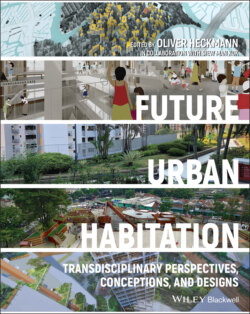Читать книгу Future Urban Habitation - Группа авторов - Страница 35
A City's Relational Opportunities
ОглавлениеAs ‘a relatively large, dense, and permanent settlement of socially heterogeneous individuals’ (Wirth 1938, p. 8), a city opens up opportunities for social networking. These three qualities – size, density, and heterogeneity – inevitably increase the number of possible interactions: ‘the potential number of people we can select from increases as the square of the population of the city itself’ (Batty 2018, p. 4). And it isn't simply numbers of possible contacts that increase. The city also offers a wide range of types of contact: ‘the personal traits, the occupations, the cultural life, and the ideas of members of an urban community, may therefore, be expected to range between more widely separated poles than those of rural inhabitants’ (Wirth 1938, p. 11).
Urbanites have more latitude when selecting contacts. They may choose to ‘acquire membership in widely divergent groups, each of which functions only with reference to a single segment of his personality’ (Wirth 1938, p. 16). Wellman (2001) terms this: ‘networked individualism’. Conventional wisdom says communities are spatially bounded entities when, in fact, communities today are personal and unique to individuals.
Personal in two senses of the word. First, every person has a personal network to call his/her own, made up of friends, family, and others, who may or may not be living in close proximity to the person. Communities today comprise ties both near and far (Chua et al. 2018). Second, every person is assumed to be responsible for cultivating his/her own network. Rainie and Wellman (2012) put it this way: ‘Networked individualism downloads the responsibility – and the burden – of maintaining personal networks on the individual. Active networking is more important than going along with the group. Acquiring resources depends substantially on personal skill, individual motivation, and maintaining the right connections’ (p. 125). City‐dwellers build social worlds ‘according to me’ (Chua et al. 2011). They curate portfolios of ties and are autonomous managers of their own social contacts (Rainie and Wellman 2012).
Second, perhaps because they are exposed to diversity whether they like it or not, urbanites are more tolerant of ‘the other’ than their non‐urban counterparts. Cities today are characterized by educational, racial, and religious heterogeneity (Beggs et al. 1996), and urbanism fosters a ‘way of life’ (Wirth 1938, p. 1), which includes a greater tolerance and willingness to accommodate differences, and this has increased over time (Tuch 1987). Consequently, although global cities are centres of diversity, they are marked by a threshold level of tolerance and an ethos of ‘intercultural citizenship’ (van Leeuwen 2010, p. 631). Many city‐dwellers are ‘cultural omnivores’, willing to partake of a variety of cultural practices and experiences (Peterson and Kern 1996). They have learned to adapt, be flexible, and code‐switch according to the variety of their contacts (Coser 1975). They are universalists, spanning the boundaries that divide groups and accommodating different cultures (Appiah 2006). Ultimately, relationships in urban contexts are more specialized, more likely to be based on friendship than on kinship or neighbourhood alone.
But do the opportunities for contact translate into actual relationships? Or do other forces thwart the bridging of groups? Here is where policy design is especially important. The city may increase the sheer number of different peoples and cultures and force them to interact, but are there mechanisms to ensure their social worlds meet in meaningful ways?
In Singapore, public housing shows how policy design can make a difference to social relationships. The Housing Development Board, the public housing agency in charge of 80% of the housing stock in Singapore, (HDB), has a strict policy of ethnic desegregation. Each public housing estate is designed with a microcosm of society in mind. The estates are socially mixed, comprising residents from the four Singaporean racial groups: Chinese (75%), Malay (15%), Indian (8%), and Others (2%). This has allowed the social mixing of racial groups in everyday life (Sim et al. 2003).
The Singaporean model is based on the principle that spatial proximity breeds social proximity. The experiment with integrated housing has produced a fairly successful social mixing of residents with different ethnic and religious backgrounds. They meet each other in the markets, provision shops, hawker (food) centres, coffee shops, and along the corridors of the public housing slab blocks (Lai 1995). Singapore prides its definition as a multicultural society, and the experiment with integrated housing has paid off in the form of the peaceful coexistence (Housing Development Board 2014).
As I see it, however, this is only a starting point. Scholars in urban design and architecture write about the design forms that best elicit sociability, noting, for example, that semi‐private spaces balance the dichotomous needs for sociability and privacy (Gehl 1986). Because much of their work focuses on the neighbourhood, its more general applicability is limited in the contemporary context. Communities today have extended far beyond the neighbourhood; we need to interrogate the broader social network, considering both long and short ties.
